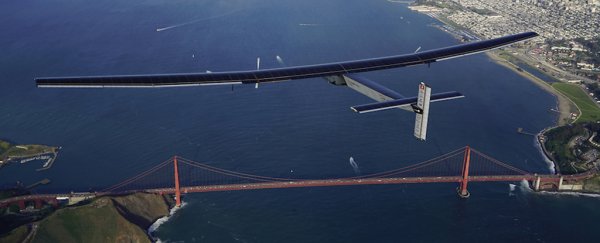After several months of maintenance and repairs in Hawaii, Solar Impulse 2 has made it all the way across the Pacific Ocean to California, breaking a bunch of world records in the process. The revolutionary solar-powered, electric plane is now three-quarters of the way through its around-the-world voyage, with nine out of 12 legs completed.
Pilot and Solar Impulse founder, Bertrand Piccard, made it from Kalaeloa in Hawaii to Mountain View, California, in 62 hours. Along the way, the support team says the aircraft broke records for distance, speed, duration, altitude, and altitude gain for an electric plane, though these achievements still need to be verified by the US Federal Aviation Administration (FAA).
Reaching a maximum altitude of 28,000 feet (8,534 metres), Solar Impulse 2 travelled a distance of 2,810 miles (4,522 km) at an average speed of 40.4 mph (65 km/h), Gizmag reports. The 17,000 solar cells on the plane's wings kept it powered during the days, with custom-made batteries supplying electricity at night.
The aeroplane's unprecedented round-the-world trip is intended to raise awareness of the potential of solar power and encourage companies to take the technology on board, even if it's not quite ready for the mass market yet.
It's also a test of the limits of human endurance, which is why the trip has been split up into chunks. The single cabin seat doubles up as both a bed and a toilet, and Piccard and fellow pilot André Borschberg have to make do with 20-minute naps every 2-4 hours.
In total, they're both going to spend around 250 hours in the cockpit, as they alternate piloting duties across the entire journey.
"It is more than an airplane: it is a concentration of clean technologies, a genuine flying laboratory, and illustrates that solutions exist today to meet the major challenges facing our society," said Piccard after the flight.
While Solar Impulse 2 can only travel at the speed of a car, it's completely self-sufficient and requires no fuel – if it wasn't for the well-being of the pilot on board, it would never have to land, and if the team manages to complete its round-the-world trip, it's going to be a significant milestone for the technology.
The endeavour, which began in March 2015, was due to be completed this summer, but a number of setbacks have led to delays: bad weather conditions, storm damage, and battery overheating have meant the Solar Impulse team has had some spells of frustration to contend with.
Now, though, the optimism is back – as you can see in the landing video below.
As CNN reports, the aircraft has new batteries, a new cooling system and US$20 million in fresh funding to make sure it reaches the finish line. After more stops in the US, Europe and Africa, the plane is expected to return to Abu Dhabi where its journey began, with some 22,000 miles (35,400 km) behind it.
